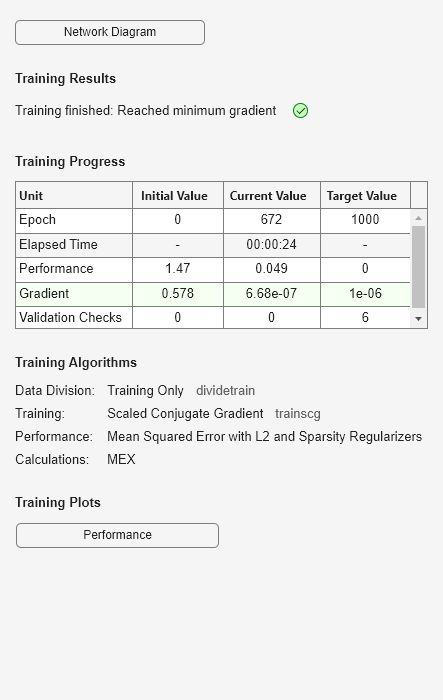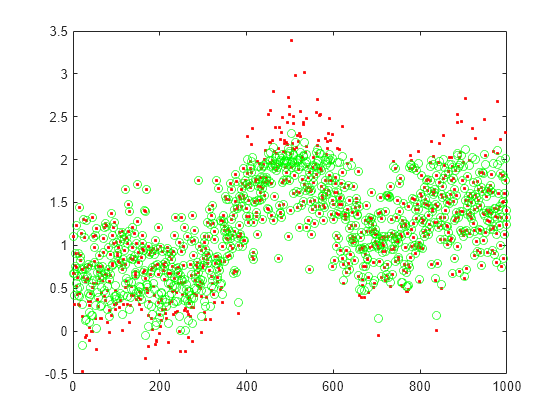trainAutoencoder
Train an autoencoder
Syntax
Description
autoenc = trainAutoencoder(X,hiddenSize)autoenc, with the hidden representation
size of hiddenSize.
autoenc = trainAutoencoder(___,Name,Value)autoenc, for any of the above
input arguments with additional options specified by one or more Name,Value pair
arguments.
For example, you can specify the sparsity proportion or the maximum number of training iterations.
Examples
Load the sample data.
X = abalone_dataset;
X is an 8-by-4177 matrix defining eight attributes for 4177 different abalone shells: sex (M, F, and I (for infant)), length, diameter, height, whole weight, shucked weight, viscera weight, shell weight. For more information on the dataset, type help abalone_dataset in the command line.
Train a sparse autoencoder with default settings.
autoenc = trainAutoencoder(X);

Reconstruct the abalone shell ring data using the trained autoencoder.
XReconstructed = predict(autoenc,X);
Compute the mean squared reconstruction error.
mseError = mse(X-XReconstructed)
mseError = 0.0167
Load the sample data.
X = abalone_dataset;
X is an 8-by-4177 matrix defining eight attributes for 4177 different abalone shells: sex (M, F, and I (for infant)), length, diameter, height, whole weight, shucked weight, viscera weight, shell weight. For more information on the dataset, type help abalone_dataset in the command line.
Train a sparse autoencoder with hidden size 4, 400 maximum epochs, and linear transfer function for the decoder.
autoenc = trainAutoencoder(X,4,'MaxEpochs',400,... 'DecoderTransferFunction','purelin');

Reconstruct the abalone shell ring data using the trained autoencoder.
XReconstructed = predict(autoenc,X);
Compute the mean squared reconstruction error.
mseError = mse(X-XReconstructed)
mseError = 0.0048
Generate the training data.
rng(0,'twister'); % For reproducibility n = 1000; r = linspace(-10,10,n)'; x = 1 + r*5e-2 + sin(r)./r + 0.2*randn(n,1);
Train autoencoder using the training data.
hiddenSize = 25; autoenc = trainAutoencoder(x',hiddenSize,... 'EncoderTransferFunction','satlin',... 'DecoderTransferFunction','purelin',... 'L2WeightRegularization',0.01,... 'SparsityRegularization',4,... 'SparsityProportion',0.10);

Generate the test data.
n = 1000; r = sort(-10 + 20*rand(n,1)); xtest = 1 + r*5e-2 + sin(r)./r + 0.4*randn(n,1);
Predict the test data using the trained autoencoder, autoenc.
xReconstructed = predict(autoenc,xtest');
Plot the actual test data and the predictions.
figure; plot(xtest,'r.'); hold on plot(xReconstructed,'go');

Load the training data.
XTrain = digitTrainCellArrayData;
The training data is a 1-by-5000 cell array, where each cell containing a 28-by-28 matrix representing a synthetic image of a handwritten digit.
Train an autoencoder with a hidden layer containing 25 neurons.
hiddenSize = 25; autoenc = trainAutoencoder(XTrain,hiddenSize,... 'L2WeightRegularization',0.004,... 'SparsityRegularization',4,... 'SparsityProportion',0.15);
Load the test data.
XTest = digitTestCellArrayData;
The test data is a 1-by-5000 cell array, with each cell containing a 28-by-28 matrix representing a synthetic image of a handwritten digit.
Reconstruct the test image data using the trained autoencoder, autoenc.
xReconstructed = predict(autoenc,XTest);
View the actual test data.
figure; for i = 1:20 subplot(4,5,i); imshow(XTest{i}); end

View the reconstructed test data.
figure; for i = 1:20 subplot(4,5,i); imshow(xReconstructed{i}); end

Input Arguments
Training data, specified as a matrix of training samples or
a cell array of image data. If X is a matrix,
then each column contains a single sample. If X is
a cell array of image data, then the data in each cell must have the
same number of dimensions. The image data can be pixel intensity data
for gray images, in which case, each cell contains an m-by-n matrix.
Alternatively, the image data can be RGB data, in which case, each
cell contains an m-by-n-3 matrix.
Data Types: single | double | cell
Size of hidden representation of the autoencoder, specified as a positive integer value. This number is the number of neurons in the hidden layer.
Data Types: single | double
Name-Value Arguments
Specify optional pairs of arguments as
Name1=Value1,...,NameN=ValueN, where Name is
the argument name and Value is the corresponding value.
Name-value arguments must appear after other arguments, but the order of the
pairs does not matter.
Before R2021a, use commas to separate each name and value, and enclose
Name in quotes.
Example: 'EncoderTransferFunction','satlin','L2WeightRegularization',0.05 specifies
the transfer function for the encoder as the positive saturating linear
transfer function and the L2 weight regularization as 0.05.
Transfer function for the encoder, specified as the comma-separated
pair consisting of 'EncoderTransferFunction' and
one of the following.
| Transfer Function Option | Definition |
|---|---|
'logsig' | Logistic sigmoid function
|
'satlin' | Positive saturating linear transfer function
|
Example: 'EncoderTransferFunction','satlin'
Transfer function for the decoder, specified as the comma-separated
pair consisting of 'DecoderTransferFunction' and
one of the following.
| Transfer Function Option | Definition |
|---|---|
'logsig' | Logistic sigmoid function
|
'satlin' | Positive saturating linear transfer function
|
'purelin' | Linear transfer function
|
Example: 'DecoderTransferFunction','purelin'
Maximum number of training epochs or iterations, specified as
the comma-separated pair consisting of 'MaxEpochs' and
a positive integer value.
Example: 'MaxEpochs',1200
The coefficient for the L2 weight
regularizer in the cost function (LossFunction),
specified as the comma-separated pair consisting of 'L2WeightRegularization' and
a positive scalar value.
Example: 'L2WeightRegularization',0.05
Loss function to use for training, specified as the comma-separated
pair consisting of 'LossFunction' and 'msesparse'.
It corresponds to the mean squared error function adjusted for training
a sparse autoencoder as
follows:
where λ is the coefficient for the L2 regularization
term and β is the coefficient for
the sparsity
regularization term. You can specify the values of λ and β by
using the L2WeightRegularization and SparsityRegularization name-value
pair arguments, respectively, while training an autoencoder.
Indicator to show the training window, specified as the comma-separated
pair consisting of 'ShowProgressWindow' and either true or false.
Example: 'ShowProgressWindow',false
Desired proportion of training examples a neuron reacts to,
specified as the comma-separated pair consisting of 'SparsityProportion' and
a positive scalar value. Sparsity proportion is a parameter of the
sparsity regularizer. It controls the sparsity of the output from
the hidden layer. A low value for SparsityProportion usually leads
to each neuron in the hidden layer "specializing" by only giving a
high output for a small number of training examples. Hence, a low
sparsity proportion encourages higher degree of sparsity. See Sparse Autoencoders.
Example: 'SparsityProportion',0.01 is equivalent
to saying that each neuron in the hidden layer should have an average
output of 0.1 over the training examples.
Coefficient that controls the impact of the sparsity regularizer in
the cost function, specified as the comma-separated pair consisting
of 'SparsityRegularization' and a positive scalar
value.
Example: 'SparsityRegularization',1.6
The algorithm to use for training the autoencoder, specified
as the comma-separated pair consisting of 'TrainingAlgorithm' and 'trainscg'.
It stands for scaled conjugate gradient descent [1].
Indicator to rescale the input data, specified as the comma-separated
pair consisting of 'ScaleData' and either true or false.
Autoencoders attempt to replicate their input at their output.
For it to be possible, the range of the input data must match the
range of the transfer function for the decoder. trainAutoencoder automatically
scales the training data to this range when training an autoencoder.
If the data was scaled while training an autoencoder, the predict, encode,
and decode methods also scale the data.
Example: 'ScaleData',false
Indicator to use GPU for training, specified as the comma-separated
pair consisting of 'UseGPU' and either true or false.
Example: 'UseGPU',true
Output Arguments
Trained autoencoder, returned as an Autoencoder object.
For information on the properties and methods of this object, see Autoencoder class page.
More About
An autoencoder is a neural network which is trained to replicate its input at its output. Training an autoencoder is unsupervised in the sense that no labeled data is needed. The training process is still based on the optimization of a cost function. The cost function measures the error between the input x and its reconstruction at the output .
An autoencoder is composed of an encoder and a decoder. The encoder and decoder can have multiple layers, but for simplicity consider that each of them has only one layer.
If the input to an autoencoder is a vector , then the encoder maps the vector x to another vector as follows:
where the superscript (1) indicates the first layer. is a transfer function for the encoder, is a weight matrix, and is a bias vector. Then, the decoder maps the encoded representation z back into an estimate of the original input vector, x, as follows:
where the superscript (2) represents the second layer. is the transfer function for the decoder, is a weight matrix, and is a bias vector.
Encouraging sparsity of an autoencoder is possible by adding a regularizer to the cost function [2]. This regularizer is a function of the average output activation value of a neuron. The average output activation measure of a neuron i is defined as:
where n is the total number of training examples. xj is the jth training example, is the ith row of the weight matrix , and is the ith entry of the bias vector, . A neuron is considered to be ‘firing’, if its output activation value is high. A low output activation value means that the neuron in the hidden layer fires in response to a small number of the training examples. Adding a term to the cost function that constrains the values of to be low encourages the autoencoder to learn a representation, where each neuron in the hidden layer fires to a small number of training examples. That is, each neuron specializes by responding to some feature that is only present in a small subset of the training examples.
Sparsity regularizer attempts to enforce a constraint on the sparsity of the output from the hidden layer. Sparsity can be encouraged by adding a regularization term that takes a large value when the average activation value, , of a neuron i and its desired value, , are not close in value [2]. One such sparsity regularization term can be the Kullback-Leibler divergence.
Kullback-Leibler divergence
is a function for measuring how different two distributions are. In
this case, it takes the value zero when and are
equal to each other, and becomes larger as they diverge from each
other. Minimizing the cost function forces this term to be small,
hence and to
be close to each other. You can define the desired value of the average
activation value using the SparsityProportion name-value
pair argument while training an autoencoder.
When training a sparse autoencoder, it is possible to make the sparsity regulariser small by increasing the values of the weights w(l) and decreasing the values of z(1) [2]. Adding a regularization term on the weights to the cost function prevents it from happening. This term is called the L2 regularization term and is defined by:
where L is the number of hidden layers, nl is the output size of layer l, and kl is the input size of layer l. The L2 regularization term is the sum of the squared elements of the weight matrices for each layer.
The cost function for training a sparse autoencoder is an adjusted mean squared error function as follows:
where λ is
the coefficient for the L2 regularization
term and β is the coefficient for
the sparsity
regularization term. You can specify the values of λ and β by
using the L2WeightRegularization and SparsityRegularization name-value
pair arguments, respectively, while training an autoencoder.
References
[1] Moller, M. F. “A Scaled Conjugate Gradient Algorithm for Fast Supervised Learning”, Neural Networks, Vol. 6, 1993, pp. 525–533.
[2] Olshausen, B. A. and D. J. Field. “Sparse Coding with an Overcomplete Basis Set: A Strategy Employed by V1.” Vision Research, Vol.37, 1997, pp.3311–3325.
Version History
Introduced in R2015b
See Also
MATLAB Command
You clicked a link that corresponds to this MATLAB command:
Run the command by entering it in the MATLAB Command Window. Web browsers do not support MATLAB commands.
选择网站
选择网站以获取翻译的可用内容,以及查看当地活动和优惠。根据您的位置,我们建议您选择:。
您也可以从以下列表中选择网站:
如何获得最佳网站性能
选择中国网站(中文或英文)以获得最佳网站性能。其他 MathWorks 国家/地区网站并未针对您所在位置的访问进行优化。
美洲
- América Latina (Español)
- Canada (English)
- United States (English)
欧洲
- Belgium (English)
- Denmark (English)
- Deutschland (Deutsch)
- España (Español)
- Finland (English)
- France (Français)
- Ireland (English)
- Italia (Italiano)
- Luxembourg (English)
- Netherlands (English)
- Norway (English)
- Österreich (Deutsch)
- Portugal (English)
- Sweden (English)
- Switzerland
- United Kingdom (English)